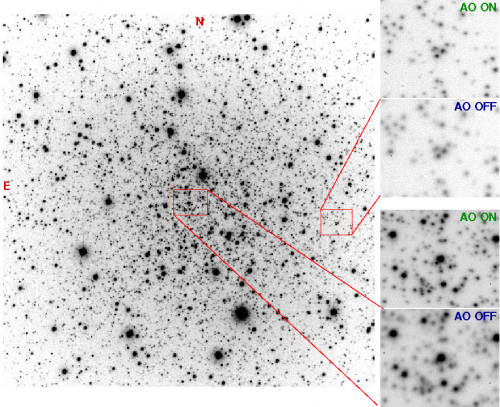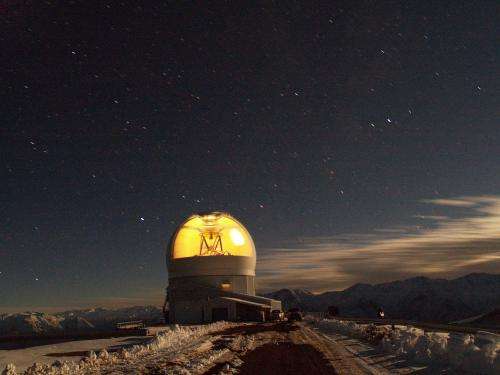A better view with adaptive optics into the heart of a globular cluster

(Phys.org) —Astronomers at the Southern Observatory for Astrophysical Research (SOAR) and the Cerro Tololo Inter-American Observatory (CTIO) have demonstrated the significant difference that sharp stellar images can make in our understanding of the properties of stars. They have observed the globular cluster NGC 6496 using a new instrument dubbed SAM, for SOAR Adaptive Module, which creates an artificial laser guide star. SAM, built by CTIO/NOAO-S, is mounted on the SOAR 4.1 meter telescope.
From the surface of the earth, stars twinkle as their image wobbles around due to the effects of the Earth's atmosphere, rather like observing a penny on the bottom of a swimming pool. By removing this wobble, using an adaptive optics system that utilizes a laser guide star, the stellar images are sharpened, and fainter stars appear. The accompanying figure shows this globular cluster, and the difference between the image of NGC 6496 with the artificial laser-produced guide star turned on and off. Turning on the artificial guide star allows the effect of the atmosphere to be determined so that the adaptive optical system can sharpens the image.

The resulting stellar images allow astronomers to make more precise measures of the colors of the stars, and for a globular cluster, this translates into a better measurement of distance, age, and what astronomers call metallicity: how much the stars are enriched with elements that are heavier than hydrogen and helium. This, in turn, allows for better understanding of the stellar evolution of the stars in these dense clusters.
There are only about 150 known globular clusters in Milky Way, important because they represent some of the oldest objects in the Galaxy. Because NGC 6496 is on the other side of the Galactic center, it is seen through a thick layer of dust. The position of this globular cluster has made it difficult to determine its basic properties. For example, previous measurements of its distance do not agree well with each other.
Luciano Fraga, Andrea Kunder and Andrei Tokovinin (in a paper accepted for publication by the Astronomical Journal) used the capabilities of SAM to sharpen star images to peer deep into this crowded cluster, obtaining more accurate results than done previously from the ground. The authors find a distance of 32,600 light years, an age of 10.5 billion years, and a value for metallicity that is much higher than in most globular clusters. To do this, they measured over 7000 stars in the cluster. Then they plotted the colors and brightness of each star, resulting in a diagram referred to as a color-magnitude diagram. This diagram immediately tells astronomers a great deal about the evolutionary phase of the stars in the cluster.
SAM works in the visible spectral region and can cover a field of 3 arc minutes, about one tenth the size of the full moon. It compensates for the lower atmospheric turbulence by using an artificial guide star created by a powerful ultra-violet laser. While this technique, called adaptive optics, has been used on other telescopes before, SAM covers a wider field of view and shorter wavelengths. Information about the SAM can be found at: www.ctio.noao.edu/new/Telescop … OAR/Instruments/SAM/
Journal information: Astronomical Journal
Provided by National Optical Astronomy Observatory




















